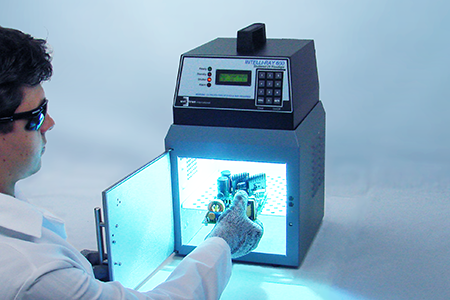In the fast-paced world of manufacturing and technology, efficiency and precision are paramount. UV curing systems have emerged as indispensable tools across various industries, revolutionizing the process of curing coatings, adhesives, and inks. In this comprehensive guide, we’ll explore the fascinating realm of UV curing systems, shedding light on their working principles, applications, and the transformative impact they’ve had on modern manufacturing.
Understanding UV Curing Systems:
What is UV Curing?
UV curing is a process that uses ultraviolet (UV) light to instantly cure or dry coatings, inks, adhesives, and other materials. UV curing systems are equipped with UV lamps that emit high-intensity UV light, triggering a photochemical reaction in the material, leading to rapid curing.
Components of UV Curing Systems:
- UV Lamps: These lamps emit UV radiation at specific wavelengths, typically in the UVA or UVB range, depending on the application.
- Reflector: The reflector enhances the efficiency of UV light distribution, directing it towards the target material.
- Power Supply: The power supply regulates and controls the intensity and duration of UV light exposure.
- Cooling System: UV curing systems often incorporate cooling mechanisms to prevent overheating during continuous operation.
- Conveyor System (if applicable): In industrial settings, a conveyor system may be integrated for seamless and continuous curing of materials.
Working Principles of UV Curing Systems:
- Initiation: The UV lamps emit UV light, which initiates the photopolymerization process in the photosensitive material.
- Photochemical Reaction: The UV light interacts with photoinitiators in the material, causing them to release free radicals or activate a curing agent.
- Polymerization: The free radicals initiate polymerization, forming a cross-linked network that rapidly solidifies the material.
- Instant Curing: Unlike traditional curing methods, UV curing achieves almost instantaneous results, leading to increased productivity and efficiency.
Applications of UV Curing Systems:
- Printing Industry: UV curing is widely used in offset, flexographic, and digital printing for quick-drying inks, coatings, and varnishes.
- Woodworking and Furniture: UV-cured coatings provide durable and high-quality finishes on wood surfaces.
- Electronics: UV curing is essential in the production of electronic devices, securing components in place with UV-cured adhesives.
- Medical Devices: UV curing is employed for bonding and sealing in the manufacturing of medical devices, ensuring precision and speed.
- Automotive Industry: UV curing is utilized for coatings on automotive components, ensuring durability and resistance to environmental factors.
- Optical Fiber Coating: UV curing is critical in the manufacturing of optical fibers, providing a protective coating that enhances performance.
- Packaging: UV-cured inks and coatings are favored in the packaging industry for their fast curing and resistance to abrasion.
Advantages of UV Curing Systems:
- Speed: UV curing is exceptionally fast, leading to reduced production times and increased throughput.
- Energy Efficiency: UV curing systems consume less energy compared to traditional heat-curing methods.
- Precision and Consistency: UV curing ensures uniform curing and coating thickness, contributing to high-quality finished products.
- Reduced Emissions: UV curing produces minimal volatile organic compounds (VOCs), contributing to a more environmentally friendly process.
- Space Efficiency: UV curing systems are compact and can be easily integrated into existing production lines.
Considerations for Implementing UV Curing Systems:
- Material Compatibility: Ensure that the materials used in the process are compatible with UV curing.
- Wavelength Selection: Choose the appropriate UV wavelength for the specific curing requirements of the material.
- Intensity and Duration: Adjust the intensity and duration of UV light exposure based on the material and desired curing results.
- Safety Measures: Implement safety measures to protect operators from exposure to UV radiation.
